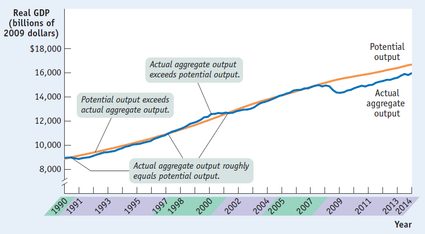GDP Gap Calculator
Use the GDP gap calculator to estimate the output gap (or GDP gap), that is the percentage difference between actual GDP and its potential level. Read on to see how to find GDP gap using the GDP gap formula as well as us explain the idea behind the output gap. Furthermore, you can get insight into some related concepts, such as:
- What does negative output gap mean?
- What is potential output?
- How to calculate potential GDP (potential output)?
If you are unfamiliar with the concept of Gross Domestic Product, our GDP calculator will give you great support. Also, if you would like to learn more, you may check the relationship between the output and unemployment rate in our Okun's law calculator.
What is output gap?
The GDP gap formula (or output gap) is the percentage difference between aggregate output (actual GDP) and its potential level, the potential output. When output exceeds its potential level, there is a positive output gap, and the economy functions above its full capacity. Employees tend to demand higher salaries, and firms are prone to use the opportunity to raise prices. The result will be higher inflation.
Conversely, in the case of a negative output gap, there will be a lot of slack in the economy. Therefore, workers will accept a steady or modest increase in wages, and firms will need to lower prices to sell their goods, resulting in lower inflation.
In other words, when the economy is producing less than its potential level (or equivalently, if the actual GDP is less than potential GDP), it is not making full use of the available productive resources. Conversely, when it produces more than its potential level, the economy becomes overheated. This economic instability initiates adjustments in prices and wages which trigger further adjustments in other economic factors, such as labor and output, pulling the economy back to its potential level.
In its nominal form, the GDP gap measures the amount by which the actual GDP is above or under the potential level of output. In our GDP gap calculator, we find its percentage value.

GDP gap calculator — the output gap formula
According to the output gap definition, the GDP gap formula is the percentage difference between actual and potential output. It takes the following simple mathematical form:
where:
- — The GDP gap (or output gap);
- — The actual GDP; and
- — The potential output.
Our GDP gap calculator uses the above output gap formula to quickly assess the missing parameter, provided you supply the other two.
What is potential GDP?
The potential GDP, or potential output, corresponds to the level of output that an economy can produce by using its given resources at a normal intensity. It means that people work their usual number of hours and factories produce at their usual rates. Output can rise above potential if people work overtime and factories run above their usual level.
In the New Keynesian Phillips curve, where the output gap is one of the key ingredients, potential output coincides with the output level that the economy would produce once all prices had fully adjusted — learn more about this in our Phillips curve calculator.
In general, the potential output typically grows at a stable rate over time, reflecting long-run GDP growth due to technological change and capital accumulation. However, actual GDP fluctuates around potential GDP in the short run: a recessionary output gap arises when actual GDP is below the potential output; an inflationary gap appears when actual aggregate GDP exceeds potential output.
FAQs
How do I calculate potential GDP for the output gap?
As the GDP gap measures the difference between the actual GDP (real GDP) and its potential level, you need to find data for these two variables to find the GDP gap:
- The real GDP is measured by national statisticians and is widely available.
- Estimating potential GDP is difficult due to its hypothetical nature and equivocal interpretation.
- One of the typical and straightforward estimation methods is based on the deviation of GDP from its long-run trend with applied statistical procedures, such as the Hodrick-Prescott (HP) filter.
What are the consequences of a negative GDP gap?
In general, the consequence of a negative GDP gap is a fall in price inflation (or even deflation), which initiates downward adjustment in the nominal interest rate. A negative GDP gap typically prompts expansionary monetary and fiscal policy to narrow the gap and improve employment and inflation.
What was the output gap in the US in 2020?
According to the U.S. Bureau of Economic Analysis, the GDP gap in the U.S. economy was -5.14 percent in 2020. It implies that the U.S. economy has been functioning below its potential level, primarily due to the economic disturbances caused by the pandemic.
What does GDP gap measure and how do I find GDP gap?
The GDP gap measures the percentage difference between the actual real GDP and its potential level. Accordingly, you need to find the GDP gap by:
-
Finding the actual real GDP.
-
Estimating its potential level.
-
Compute their percentage difference:
(Real GDP - Real Potential GDP) / Real Potential GDP
Can a negative GDP gap cause deflation?
Yes, it can. If the actual real GDP is considerably below its potential level and is not narrowed by a sufficient monetary and fiscal expansion, it may result in deflation.